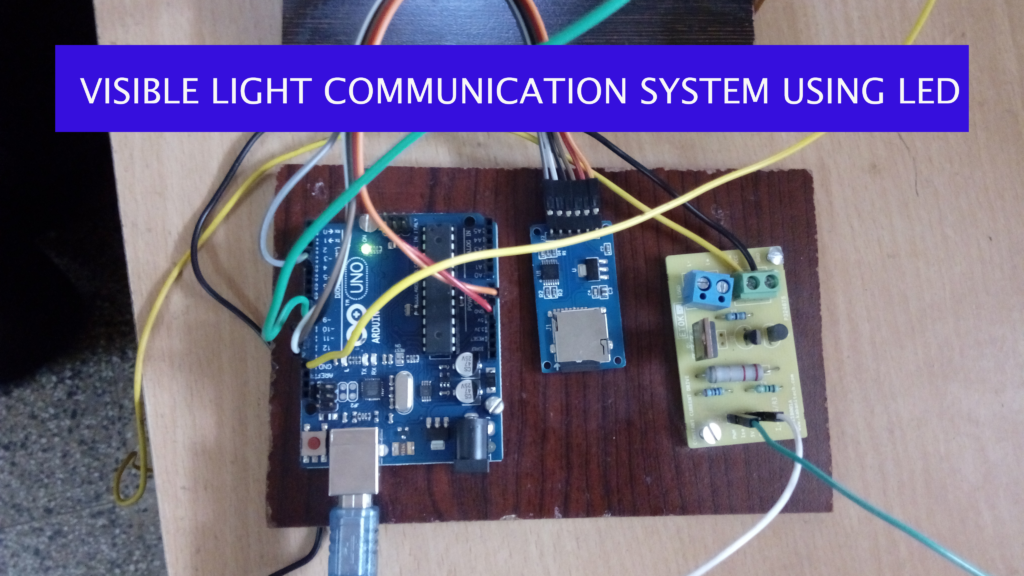Abstract
Optical communication uses light as its medium. The optical wireless communication systems include infra-red spectrum and visible light spectrum, for IR and visible light communication. The existing spectrum is becoming insufficient as the demand increases. Thus, a system is developed using a Line-Of-Site property of light. This paper is to develop a light based data communication system using LED known as Li-Fi. The input is converted to digital data and transmitted through a transmitter module. From the channel, the receiver receives the data and decodes to the original data and is retrieved back.
Li-Fi is an optical communication system which uses light for data transmission. In Li-Fi, visible light region within the electro-magnetic spectrum is used. The visible light communication technology is used for transmitting and receiving data at very high speed [8]. The commonly used data transmission technique is Wi-Fi, which has a frequency band of 2.4GHz. The main problem faced by this is the limited spectrum size and the higher radiations emitted to the atmosphere. The number of users to the Wi-Fi is increasing thus the channel allocation is more and thus speed is decreasing. To solve these problems a harmless communication system is developed using LED in visible light spectrum which has higher spectrum size.
Commonly antennas are used for transmission and which will produce radiations to the atmosphere. Here, LED is used as transmitter and light is the medium of transmission, which is then received using a photodetector. As light is used there is no radiation and is not harmful. High bright light emitting diode will produce incoherent light, so it can be considered for pervasive communication with Li-Fi. While using LED there exist an opportunity to support the existing network infrastructure. Li-Fi is mainly focused on interior security and it supports user mobility and multi-user access.
Watch Video…..!
This technology is based on the Line-Of-Sight (LOS) property of the light. The data transmission is done through the light rays. Data is sent in the form of binary values. The intensity variation given to the LED is used for transmitting binary data. LED consists of three different intensity modes, maximum intensity mode, medium intensity mode and minimum intensity mode. The super bright white LED is used for saving energy and power. In this project, a high-speed transmitting section working based on ON-OFF keying and receiver section is made where the error is being corrected and the actual data is extracted.
Applications
- Underwater communication as light can penetrate to larger distances.
- Li-Fi creates a new cyber-secure wireless network.
- In hospitals, for the use of secure networked medical instruments and keeping patient records.
- In intrinsically safe environments such as petrochemical plants and oil platforms.
Advantages
- Energy efficiency.
- Intrinsic security.
- High data rate capability.
- Integrated networking capability.
The concept of Li-Fi attracts a great deal of interest. Here the experimental set-up includes a transmitter section that transmits data and receiver section which includes a photo-detector and a comparator in receiving the transmitted data which converts the received signals into actual data sequence. With the better performance of both transmitting and receiving section and bringing new modulation schemes like OFDM in to act speed of communication can be tremendously increased which will eventually satisfy the users demand for better speed and more secure communication.
As the population increased tremendously, the number of devices accessing wireless internet also increased making it more unreliable. The shortage of radio frequency bandwidth, will be solved by Li-Fi technology developments. The aircraft or hospitals where the traditional Wi-Fi network isn’t allowed can use Li-Fi access. This technology is still under research and surely a breakthrough in communication field. The developments made in this field will make this technology soon be used in our daily lives.
Next : http://www.investinproject.com/2018/04/18/vibration-based-unconventional-robotic-structures/

